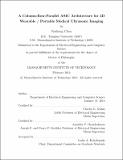A Column-Row-Parallel ASIC architecture for 3D wearable / portable medical ultrasonic imaging
Author(s)
Chen, Kailiang
DownloadFull printable version (6.256Mb)
Alternative title
Column-Row-Parallel application-specific integrated circuit architecture for 3D wearable / portable medical ultrasonic imaging
Other Contributors
Massachusetts Institute of Technology. Department of Electrical Engineering and Computer Science.
Advisor
Charles G. Sodini and Anantha P. Chandrakasan.
Terms of use
Metadata
Show full item recordAbstract
This work presents a scalable Column-Row-Parallel ASIC architecture for 3D wearable / portable medical ultrasound. It leverages programmable electronic addressing to achieve linear scaling for both hardware interconnection and software data acquisition. A 16x16 transceiver ASIC is fabricated and flip-chip bonded to a 16x16 capacitive micromachined ultrasonic transducer (CMUT) to demonstrate the compact, low-power front-end assembly. A 3D plane-wave coherent compounding algorithm is designed for fast volume rate (62.5 volume/s), high quality 3D ultrasonic imaging. An interleaved checker board pattern with I&Q excitations is also proposed for ultrasonic harmonic imaging, reducing transmitted second harmonic distortion by over 20dB, applicable to nonlinear transducers and circuits with arbitrary pulse shapes. Each transceiver circuit is element-matched to its CMUT element. The high voltage transmitter employs a 3-level pulse-shaping technique with charge recycling to enhance the power efficiency, requiring minimum off-chip components. Compared to traditional 2-level pulsers, 50% more acoustic power delivery is obtained with the same total power dissipation. The receiver is implemented with a transimpedance amplifier topology and achieves a lowest noise efficiency factor in the literature (2.1 compared to a previously reported lowest of 3.6, in unit of mPa - [square root sign]mW/Hz). A source follower stage is specially designed to combine the analog outputs of receivers in parallel, improving output SNR as parallelization increases and offering flexibility for imaging algorithm design. Lastly, fault-tolerance is incorporated into the transceiver to deal with faulty elements within the 2D MEMS transducer array, increasing yield for the system assembly.
Description
Thesis: Ph. D., Massachusetts Institute of Technology, Department of Electrical Engineering and Computer Science, 2014. Cataloged from PDF version of thesis. Includes bibliographical references (pages 163-174).
Date issued
2014Department
Massachusetts Institute of Technology. Department of Electrical Engineering and Computer SciencePublisher
Massachusetts Institute of Technology
Keywords
Electrical Engineering and Computer Science.